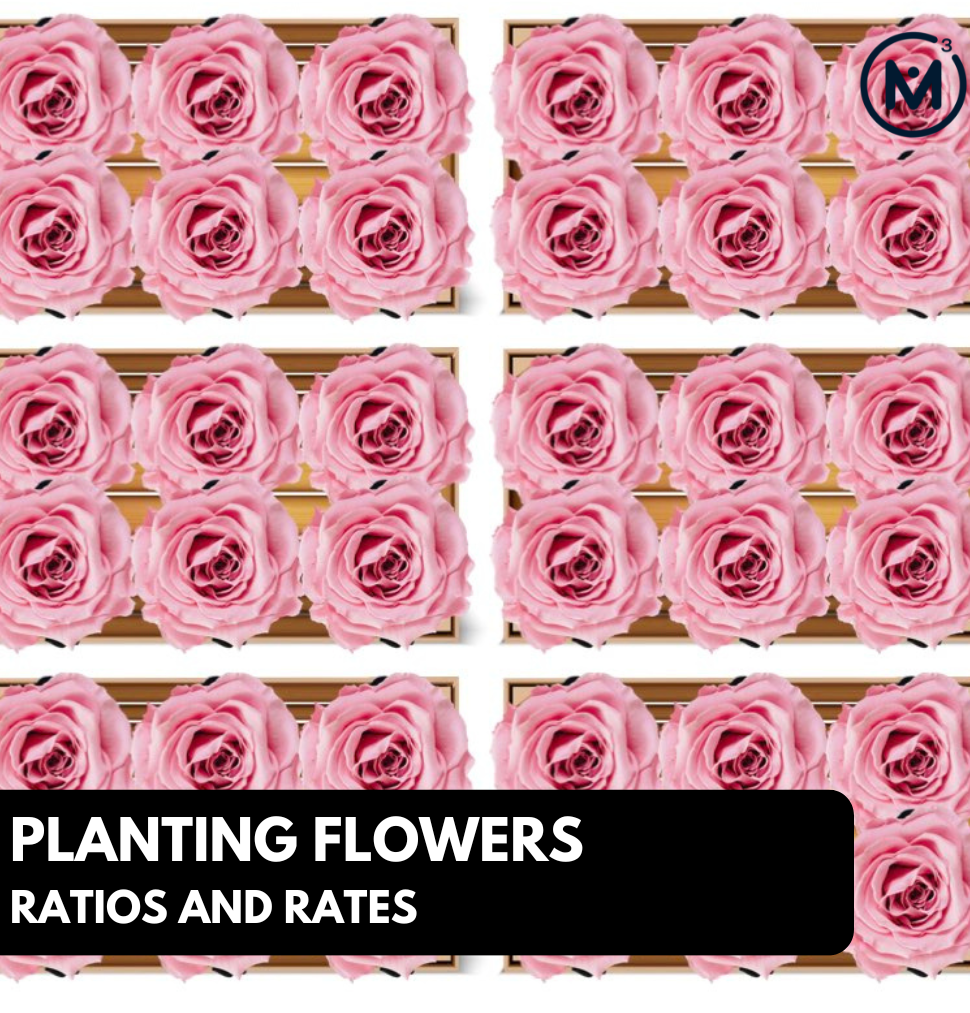PLANTING FLOWERS [DAY 4]
RATIOS AND RATES
Introduction to ratios and rates. Students will explore both types of ratios; composed units and multiplicative comparison. They will use partitive division to reveal a rate and quotative division to determine a scale factor.
Intentionality
Math Talk
Visual Math Talk Prompt #1
Visual Math Talk Prompt #2
Visual Math Talk Prompt #3
Visual Math Talk Prompt #4
Purposeful Practice
Resources & Downloads
Educator Discussion Area
Intentionality & Unit Overview

Length of Unit: 5 Days
Access each lesson from this unit using the navigation links below
Students will explore multiplicative comparison ratios and reveal scale factors through quotative division.
Intentionality…
The purpose of the Day 4 activities is to reinforce key concepts from Day 3. Students will engage in a string of related problems through a math talk and will have an opportunity to complete independent purposeful practice. The math talk and purposeful practice serve to develop a deeper understanding of the following big ideas.
- There are two types of ratios; composed unit and multiplicative comparison;
- A multiplicative comparison is a ratio with the same unit;
- The scale factor between a multiplicative comparison can be revealed through quotative division.
Math Talk
Present the following multiplicative comparison ratios one at a time. Create a context to define the units for each ratio. Focus on ratios with the same units. For each ratio, determine the scale factor. How many times greater. Encourage students to use a model to justify their thinking.
A possible context to consider would be leveraging the height of sunflowers (or other plants).
For the first problem in this string, your prompt might sound like:
One rosebush is currently 32 cm tall, while a tulip is 8 cm tall. How many times taller is the rosebush than the tulip? What fraction of the whole rosebush is the height of the tulip?
If you begin with a context comparing lengths, then you might consider continuing with length comparisons.
32 : 8
42 : 6
55 : 10
30 : 9
As an additional opportunity to extend, you can also explore the smaller quantity relative to the larger if you feel it is appropriate based on student readiness. For example, 32 is four times greater than 8 or you could say that 8 is one fourth as great as 32.
32 cm ÷ 8 cm per group = 4 groups
8 cm ÷ 32 cm per group = ¼ groups
You can learn more about rates, ratios and the roadmap to proportional relationships through the course: The Concept Holding Your Students Back.
While you can facilitate this math talk by verbally stating the context and modelling student thinking on a chalkboard/whiteboard or with digital ink, you might find it helpful to leverage the visual math talk videos with built in “pause” prompts to allow for student thinking time.
Visual Math Talk Prompt #1
The first visual math talk prompt in this string of related problems is actually two (2) prompts related to the multiplicative comparison ratio 32:8 comparing the height of a rosebush and a tulip.
You can facilitate this verbally or consider leveraging the silent solution visual math talk prompt video below:
We begin with comparing how many times bigger the 32 cm rosebush is than the 8 cm tulip.
![Planting Flowers [Day 4] - Purposeful Practice - 01 - MATH TALK Ratio 32 to 8 image001](https://learn.makemathmoments.com/wp-content/uploads/2021/07/Planting-Flowers-Day-4-Purposeful-Practice-01-MATH-TALK-Ratio-32-to-8-image001-1024x576.jpeg)
While students are encouraged to leverage the strategy and mathematical model of their choosing, modelling for the group using bars or a double number line can be helpful to see the iterations of one quantity compared to the other to reveal a scale factor.
![Planting Flowers [Day 4] - Purposeful Practice - 01 - MATH TALK Ratio 32 to 8 image002](https://learn.makemathmoments.com/wp-content/uploads/2021/07/Planting-Flowers-Day-4-Purposeful-Practice-01-MATH-TALK-Ratio-32-to-8-image002-1024x576.jpeg)
The first prompt also asks students what fraction of the whole rosebush is the height of the tulip.![Planting Flowers [Day 4] - Purposeful Practice - 01 - MATH TALK Ratio 32 to 8 image003](https://learn.makemathmoments.com/wp-content/uploads/2021/07/Planting-Flowers-Day-4-Purposeful-Practice-01-MATH-TALK-Ratio-32-to-8-image003-1024x576.jpeg)
Some of the same models can be leveraged to now multiplicatively compare the height from the other perspective. Now, we’re looking for how many fractional iterations or copies of the rosebush height can we see in the height of the tulip?
![Planting Flowers [Day 4] - Purposeful Practice - 01 - MATH TALK Ratio 32 to 8 image004](https://learn.makemathmoments.com/wp-content/uploads/2021/07/Planting-Flowers-Day-4-Purposeful-Practice-01-MATH-TALK-Ratio-32-to-8-image004-1024x576.jpeg)
It will soon become apparent that the tulip is 1 fourth the height of the rosebush and therefore, we can say that the tulip is 1 fourth times as tall as the rosebush on average.
Visual Math Talk Prompt #2
The second visual math talk prompt in this string of related problems is also two (2) prompts, but this time related to the multiplicative comparison ratio 42:6.
Again, facilitate this verbally or consider leveraging the silent solution visual math talk prompt video below:
Similar to problem #1, we begin with comparing how many times bigger the taller rosebush is than the shorter tulip.
![Planting Flowers [Day 4] - Purposeful Practice - 02 - MATH TALK Ratio 42 to 6 image001](https://learn.makemathmoments.com/wp-content/uploads/2021/07/Planting-Flowers-Day-4-Purposeful-Practice-02-MATH-TALK-Ratio-42-to-6-image001-1024x576.jpeg)
By leveraging quotative division, students will be able to see that seven (7) copies of the tulip’s height is equivalent to the height of the rosebush.
![Planting Flowers [Day 4] - Purposeful Practice - 02 - MATH TALK Ratio 42 to 6 image002](https://learn.makemathmoments.com/wp-content/uploads/2021/07/Planting-Flowers-Day-4-Purposeful-Practice-02-MATH-TALK-Ratio-42-to-6-image002-1024x576.jpeg)
As we now compare the heights from the perspective of the shorter flower, students may begin to recognize the reciprocal relationship we are emerging.
![Planting Flowers [Day 4] - Purposeful Practice - 02 - MATH TALK Ratio 42 to 6 image003](https://learn.makemathmoments.com/wp-content/uploads/2021/07/Planting-Flowers-Day-4-Purposeful-Practice-02-MATH-TALK-Ratio-42-to-6-image003-1024x576.jpeg)
Since the rosebush is 7 times the height of the tulip, the tulip must be 1 seventh as tall as the rosebush.
![Planting Flowers [Day 4] - Purposeful Practice - 02 - MATH TALK Ratio 42 to 6 image004](https://learn.makemathmoments.com/wp-content/uploads/2021/07/Planting-Flowers-Day-4-Purposeful-Practice-02-MATH-TALK-Ratio-42-to-6-image004-1024x576.jpeg)
Visual Math Talk Prompt #3
Login/Join to access the entire Visual Prompt, downloadable slide decks and printable handouts for this lesson and all problem based units.
Visual Math Talk Prompt #4
Login/Join to access the entire Visual Prompt, downloadable slide decks and printable handouts for this lesson and all problem based units.
Purposeful Practice
While Students Are Practicing…
Login/Join to access the entire Teacher Guide, downloadable slide decks and printable handouts for this lesson and all problem based units.
Questions: Ratios
Question #1:
Login/Join to access the full teacher guides, downloadable slide decks and printable handouts for this lesson and all problem based units.
Question #2:
Login/Join to access the full teacher guides, downloadable slide decks and printable handouts for this lesson and all problem based units.
Question #3:
Login/Join to access the full teacher guides, downloadable slide decks and printable handouts for this lesson and all problem based units.
Question #4:
Login/Join to access the full teacher guides, downloadable slide decks and printable handouts for this lesson and all problem based units.
Question #5:
Login/Join to access the full teacher guides, downloadable slide decks and printable handouts for this lesson and all problem based units.
Resources & Downloads
Login/Join to access the entire Teacher Guide, downloadable slide decks and printable handouts for this lesson and all problem based units.
Educator Discussion Area
Login/Join to access the entire Teacher Guide, downloadable slide decks and printable handouts for this lesson and all problem based units.
Explore Our 60+ Problem Based Units
This Make Math Moments Lesson was designed to spark curiosity for a multi-day unit of study with built in purposeful practice, number talks and extensions to elicit and emerge strategies and mathematical models.
Dig into our other units of study and view by concept continuum, grade or topic!


